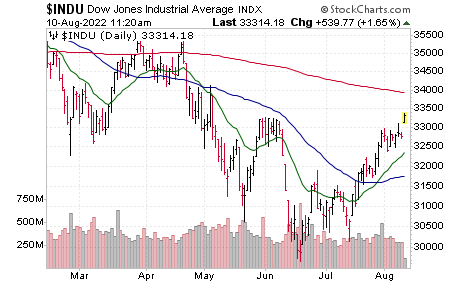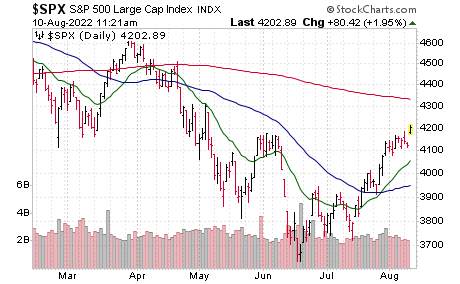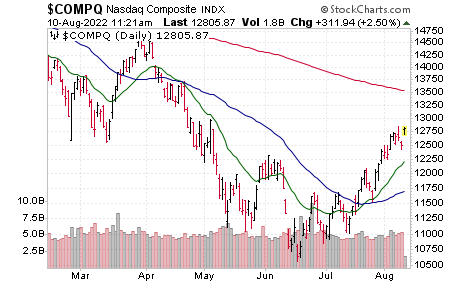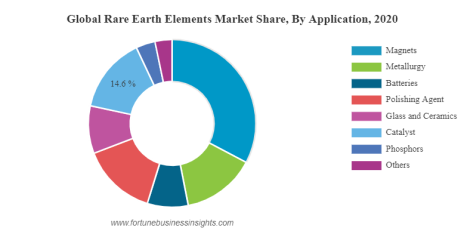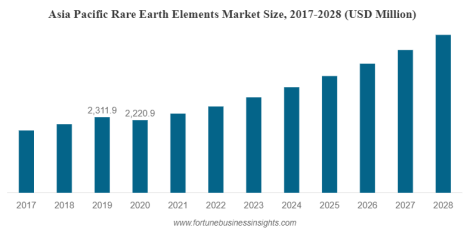The market looks pretty good these days. I’m not saying we are completely out of the woods, but the indicators are promising. The Dow Jones Industrial Average has risen about 1,500 points since last issue. And while Energy (up 36.8%) and Utilities (up 3.7%) are the only two sectors ahead for the year, we’re seeing positive moves in several other areas.
On the good news side, expectations for inflation seem to be tempering. We’ll know more tomorrow, but right now economists are calling for a decline in the inflation rate from 9.1% in July to 8.7%. And in better tidings, the three-year inflation rate is now forecast at 3.2%, down from 3.6%.
Cabot Stock of the Month Issue: August 11, 2022
Market Overview
The market looks pretty good these days. I’m not saying we are completely out of the woods, but the indicators are promising. The Dow Jones Industrial Average has risen about 1,500 points since last issue. And while Energy (up 36.8%) and Utilities (up 3.7%) are the only two sectors ahead for the year, we’re seeing positive moves in several other areas.
On the good news side, expectations for inflation seem to be tempering. We’ll know more tomorrow, but right now economists are calling for a decline in the inflation rate from 9.1% in July to 8.7%. And in better tidings, the three-year inflation rate is now forecast at 3.2%, down from 3.6%.
Also optimistic is the employment rate. Economists are loathe to say we’ve entered a recession—despite two consecutive quarters of negative growth—due to the healthy employment climate. The unemployment rate declined a tenth of a point, to 3.5% in July. And last week—in a surprising move—non-farm payrolls came in at 528,000—significantly higher than June’s 398,000 and the forecast of 258,000.
The Federal Reserve hiked rates again, by another 75 basis points, and economists are expecting at least another 50-75 basis points rise by the end of the year—all in hopes of stemming inflation.
The markets responded to the rise by sending the indexes higher. We’ll just have to wait and see how the market greets the next inflation numbers to determine if this latest rally holds.
In the meantime, consumers are still spending. And while the housing market has softened, prices are still mostly steady, and folks are still getting mortgages, albeit at higher rates.
For now, judicious stock picking is the key to higher portfolio gains. We’ll continue to look for undervalued stocks and ETFs that have strong fundamentals and growing momentum.
Featured Recommendation
MP Materials Corp. (MP): Turning “Rare” Minerals into Profits
With the market seemingly rebounding, and ever-growing rhetoric about sourcing manufacturing and other materials domestically, I thought it would be a good time to look at an American company that is mining some pretty “rare” materials which are finding their way into thousands of tech-related products worldwide.
The company is MP Materials Corp., and the recommendation comes from Carl Delfeld, Chief Analyst of Cabot Explorer. MP Materials is an emerging company, founded in Las Vegas in 2017. The business owns and operates rare earth mining and processing facilities, including the Mountain Pass Rare Earth mine in California. The company offers rare earth metals cerium, lanthanum, neodymium, praseodymium, and samarium.
In his recent Cabot Explorer issue, Carl had this to say about MP Materials:
“Imagine an America that produces no oil and a China that produces 80%-85% of the world’s oil. That’s America’s situation when it comes to rare earths and many rare strategic metals. It is a much bigger risk to the America-tech-led economy than OPEC ever was.
These strategic rare metals are not only critical to American technology; they are essential to our modern economy—from smartphones to our most advanced weapons systems. Examples of uses of rare earth metals include:
- An F-35 fighter requires 920 pounds of rare earths.
- An Arleigh Burke destroyer requires 5,200 pounds of rare earths.
- A Virginia-class submarine requires 9,200 pounds of rare earths.
Yet America does not now produce any rare earth oxides, while China produces 85% of world supply.
Semiconductors, the brains of modern technology, are full of these critical materials and Asia now produces about 75% of global semiconductor chips.
And these chips all require not only rare earths but a dozen or more critical materials that China dominates as well.
MP Materials (named after its mining and processing center in Mountain Pass, CA) emerged from the Chapter 11 of Molycorp and is the only producing rare earths mine in the United States. At one time in the 1990s, it was producing upwards of 40% of the world’s rare earths.
MP has made some interesting news this year. Its first-quarter revenues of $166.3 million represented 50% of the company’s revenues from all of 2021. This is due to the high pricing of Neodymium (Nd) and Praseodymium (Pr) this year.
Gross margins in Q1 2022 were 88%, up from 81% in 2021, but I expect this will fall for the balance of the year. Either way, MP is poised to improve its Net Income to US$168.4 million.
MP has done a good job in its sales price to China for their rare earth concentrate. The company is getting somewhere in the range of 40-50% of market value, which is high versus traditional pricing for concentrate.
In April a definitive supply agreement was announced between MP Materials and GM to supply rare earth alloy and magnets for GM’s electric vehicle (EV) program.
I would expect that MP, with the input from Shenghe Resources (a related 9% investor in MP whose ultimate parent is Shenghe Resources, a rare earth company listed on the Shanghai Stock Exchange), is a buyer of MP’s rare earth concentrate that accounts for more than 90% of MP’s product sales.
Other recent news was that the US Department of Defense (DOD) granted MP Materials $35 million to build a heavy rare earths refinery at Mountain Pass.
Given the strategic importance of MP Materials, it should continue to have strong government support and an allocation to this stock offers you the following:
- MP is a fundamental way to play clean tech, defense, semiconductors, and other advanced and emerging technologies through some of their basic inputs—rare earths,
- As a real asset commodity, MP is a hedge on inflation, and,
- MP can be seen as a strategic hedge on rising tensions in Asia and between the US and China with flashpoints in Asia—including Taiwan—since China could disrupt rare earth supplies, sending prices sharply higher.”
BUY A HALF POSITION
MP Materials Corp. (MP) 52-Week Low/High: $ 27.48 - 60.19 Shares Outstanding: 177.53 million Dividend Yield: n/a https://mpmaterials.com | Why MP Materials: Accelerating industry demand Materials are difficult to access One-of-a-kind American company Inflation hedge Undervalued |
About the Analyst: Carl Delfeld, Cabot Explorer
Carl received his Master’s in Law and Diplomacy at the Tufts Fletcher School; worked for the First National Bank of Boston (now Bank of America) in London, serving as director of the Japan and South Korea Group; served as vice president at the investment bank Robert W. Baird & Company, developing new business in Tokyo, Hong Kong and Sydney; was Asia advisor to the U.S. Congressional Joint Economic Committee, the U.S. Finance Committee and the U.S. Department of the Treasury; wrote for Forbes Asia and the Far Eastern Economic Review; served as a member on the U.S. National Committee on Pacific Economic Cooperation and the Japan-U.S. Friendship Commission; was chairman of the Asian Pension Forum. Carl has just released his latest book: Power Rivals: America and China’s Superpower Struggle.
Additional books Carl has written include:
Red, White and Bold: The New American Century Paperback,
Think Global, Grow Rich: 7 Principles for Building a Global Portfolio,
The New Global Investor: Using ETFs to Build Smarter, Simpler and Safer Portfolios.
I’ve known Carl since my days of producing video interviews for the Money Show. He was always one of my favorite participants, as his knowledge and expertise of investing around the world is comprehensive. So, when I was looking to add a unique stock to our portfolio, I knew who to ask. Here are excerpts from my interview with Carl:
Nancy: The Guide to Cabot Explorer highlights your investing strategy as “ideas outside of the mainstream investing world.” Would you please elaborate on the types of ideas you are looking for?
Carl: The mission of the Cabot Explorer is to follow the most promising growth trends around the world and then find the best stocks that exploit these opportunities.
Right now, the trends and sectors that we are following most closely are semiconductors, robotics, strategic and critical materials, nuclear energy, cyber protection, and the electrification of the grip including electric vehicles and clean tech.
Nancy: Which parts of the world are your favorites when it comes to looking for new investing ideas?
Carl: Most of our ideas come from well-developed regions such as North America and Europe, but we are very open to stocks from emerging markets in Asia and Latin America. The current Explorer recommendations are based primarily in America with one each from Germany, Japan, Chile, and China.
Nancy: What are the most important criteria that you use when analyzing the stocks that you select for your newsletter?
The fundamentals have to be solid. And then the best ideas come from both the high growth and deep value sides of the spectrum. Normally, my goal is to pick a stock that has the potential to double in 6-12 months. Oftentimes, they do much better.
Nancy: I enjoy reading your macroeconomic information and outlook in your newsletter and appreciate the world view that you offer to your subscribers. With that in mind, how important are currency and geopolitical factors when you analyze a foreign stock? What other specific criteria do you employ when analyzing companies outside the U.S.?
Carl: Big-picture macro views are somewhat important, but analyzing the company’s prospects is much more important. I do think that the current U.S.-China rivalry is going to greatly impact markets over the rest of this decade. I’m pretty much avoiding Chinese stocks and leaning more to the U.S., Europe, Southeast Asia, and Latin America.
I really do not take into account currency movements.
Portfolio and Industry Update
GitLab (GTLB) has just received additional analyst coverage from Needham, with a “Buy” rating and a target price of $70. No earnings date announcement yet, but Wall Street expects the company to produce EPS of -$0.23 on revenues of $94.5 million.
Insiders are showing confidence in the shares, buying 18 million shares in the past three months. Also, seed investor Khosla Ventures Seed C, L.P added more shares, raising its ownership in GitLab to more than 10% of outstanding shares.
The shares of GTLB are up 31% since our recommendation. Continue to HOLD.
Invesco Dow Jones Industrial Average Dividend ETF (DJD) is still trading in a buyable range. The largest sectors in this ETF are Healthcare (22.74% of assets) and Technology (17.94%). Continue to BUY.
M/I Homes (MHO) reported a strong quarter, earning $4.79 per share, beating the analyst estimates of $3.78 per share. Housing is slowing, but at this point, I’m not anticipating a meltdown and feel that M/I will continue to benefit from strong employment and housing prices, as well as steadying interest rates. The shares continue to be undervalued at about 73% of the current $63.02/share of tangible book value – a substantial discount when the company’s fundamental outlook is at worst moderately weak. Continue to BUY.
QUALCOMM Inc. (QCOM), our newest recommendation, is up about 7% since our recommendation, a bit off its highs, as President Biden signed the new Chips and Science Act (CHIPS), which will provide grants and subsidies worth $280 billion to the U.S. technology and semiconductor industry.
QCOM beat earnings estimates by 54% and revenues by 36%, mainly due to soaring smartphone royalties (up 59%). But it also reduced its guidance on the forecast for lower phone sales, and the market objected, sending the shares down.
But as Tom Hutchinson, Chief Analyst for Cabot Dividend Investor reports, “the company still expects 23% year-over-year revenue growth for the rest of the year. It should also benefit as 5G gets applied to many more devices. Slower sales were already priced into the stock. Meanwhile it sells at just 12 times forward earnings with better than 20% growth ahead even in a recession.” Continue to BUY.
| Company | Symbol | Date Bought | Price Bought | Price on 8/10/22 | Dividends YTD | Div Freq. | Gain/ Loss % | Rating |
| GitLab Inc. | GTLB | 4/13/22 | 49.02 | 68.51 | N/A | N/A | 39.77% | Hold |
| Invesco Dow Jones Industrial Average Dividend ETF | DJD | 5/13/22 | 44.41 | 43.61 | N/A | N/A | -1.79% | Buy |
| M/I Homes, Inc. | MHO | 6/10/22 | 43.75 | 47.40 | N/A | N/A | 8.34% | Buy |
| MP Materials Corp. | MP | NEW | -- | 38.31 | N/A | N/A | --% | Buy a Half |
| QUALCOMM Incorporated (QCOM) | QCOM | 7/15/22 | 143.76 | 145.78 | N/A | N/A | 2.25% | Buy |
Rare Earth Elements: What’s the Big Deal?
Number one, they are hard to get; and number 2, the demand for them is very high.
So, what are they? Rare earth elements (REE) consist of seventeen metallic elements, including the fifteen lanthanides (15 naturally occurring metallic chemical elements, whose atomic numbers fall between 57 (Lanthanum) and 71 (Lutetium)) on the periodic table, plus scandium and yttrium.
And these elements are critical parts of most high-tech devices.
Rare earth elements are used to make magnets that are an essential part of more than 200 high-tech devices, including cellphones, EV and hybrid automobiles, computer hard drives, and flatscreen monitors and televisions. They are also essential to major defense applications including electronic displays, guidance systems, lasers, and radar and sonar systems.
For example, the U.S. Geological Survey news release “Going Critical” notes, “Magnets made of REE often represent only a small fraction of the total weight, but without them, the spindle motors and voice coils of desktops and laptops would not be possible.”
The supply side of procuring rare earth elements has become very lopsided. Back in 1993, the U.S. produced 33%; China, 38%; Australia, 12%; and Malaysia and India, 5% each. The remainder came from sources including Brazil, Canada, South Africa, Sri Lanka, and Thailand.
Today, China accounts for more than 97% of global production.
The total market for REE is expected to expand from $2,831.0 million in 2021 to $5,520.2 million in 2028.
And that’s great news for MP Materials! The company just reported its second-quarter results, posting EPS of $0.43, up from $0.15 a year ago, and higher than Wall Street’s $0.35 estimate. Revenue rose to $143.56 million, also beating estimates of $128.75 million.
Part of the improvement was due to rising oxide prices due to increased demand, particularly from the EV industry.
Right now, MP is producing rare earth concentrate that is then shipped to China for processing. But that’s about to change. The company intends to be able to process the elements into oxides in California by the end of this year and will also begin to build magnets in Texas in its own facility, scheduled to be completed by late 2023. Once these two innovations are finished, the company expects to double its EBITDA, to $900 million to $1 billion.
Right now, the shares of MP remain undervalued. But with the rising demand from the defense and technology industry, as well as the EV market (as seen below), I look for growing momentum in the shares.

BEV = battery electric vehicle
PHEV = plug-in-hybrid-electric vehicle
The next Cabot Money Club Stock of the Month issue will be published on September 15, 2022.
About the Analyst
Nancy Zambell
Nancy Zambell has spent 30 years educating and helping individual investors navigate the minefields of the financial industry. She has created and/or written numerous investment publications, including UnDiscovered Stocks, UnTapped Opportunities, and Nancy Zambell’s Buried Treasures under $10. Nancy has worked with MoneyShow.com for many years as an editor and interviewer for their on-site video studios.
As a lecturer and educator, Nancy has led seminars for individual investors at the National Association of Investors, Investment Expo and the Money Show. She has also taught finance, economics and banking at the college level, and has been quoted extensively in The Wall Street Journal, Investor’s Business Daily, USA Today, and BusinessWeek.
Nancy’s book, Make Money Buying & Selling Stocks is an introduction for new investors and a reminder for experienced investors on how to profit in the stock market.

